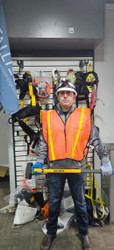The construction industry is vital to the development of infrastructure and buildings, but it is also one of the most dangerous sectors when it comes to workplace safety. Construction sites are rife with potential hazards that can lead to accidents, injuries, and even fatalities. Understanding these common hazards and taking proactive steps to prevent them is crucial to ensuring the well-being of construction workers. In this article, we will explore five common workplace hazards in construction and discuss how to prevent them.
1. Falls
Falls are the leading cause of injuries and fatalities in the construction industry. Workers often perform tasks at heights, such as working on scaffolding, roofs, or ladders, which increases the risk of falling. To prevent falls:
- Use guardrails, safety nets, and personal fall arrest systems.
- Provide adequate training on fall protection and safe work practices.
- Regularly inspect and maintain equipment like ladders and scaffolds.
- Ensure workers wear appropriate personal protective equipment (PPE) like helmets and harnesses.
2. Struck-By Accidents
Struck-by accidents occur when workers are hit by objects or vehicles on a construction site. This includes incidents involving vehicles, heavy equipment, tools, and materials. To prevent struck-by accidents:
- Establish clear work zones and separate pedestrians from moving equipment.
- Require high-visibility clothing for all workers.
- Conduct regular safety briefings and communicate potential hazards.
- Implement strict equipment inspection and maintenance protocols.
3. Electrocution
Electrocution is a significant hazard on construction sites, as workers often come into contact with live electrical sources or damaged wiring. To prevent electrocution:
- Ensure electrical systems are properly grounded and maintained.
- Identify and mark electrical hazards.
- Use non-conductive tools and equipment.
- Provide electrical safety training for all workers.
4. Trenching and Excavation Hazards
Working in trenches and excavations is another high-risk activity in construction. Collapses can lead to serious injuries and fatalities. To prevent trenching and excavation hazards:
- Properly shore, slope, or shield trenches.
- Conduct regular inspections of trenching sites.
- Keep heavy equipment away from trench edges.
- Train workers on safe excavation practices and emergency response.
5. Respiratory Hazards
Construction sites often have airborne hazards such as dust, fumes, and hazardous chemicals. These can lead to respiratory problems over time. To prevent respiratory hazards:
- Provide workers with appropriate respiratory protection, such as masks or respirators.
- Implement proper ventilation and dust control measures.
- Store and handle chemicals safely, following recommended guidelines.
- Conduct regular air quality monitoring.
In addition to these specific hazards, it's essential to establish a comprehensive safety program on construction sites. This program should include ongoing training, regular safety meetings, hazard assessments, and a culture of shared responsibility for safety among all team members.
Remember that construction safety is a collective effort involving employers, workers, and regulatory authorities. The construction industry must prioritize safety to reduce accidents and create a safer working environment. By understanding these common hazards and implementing preventative measures, the industry can significantly reduce the risk of workplace accidents and protect the well-being of its workforce.


